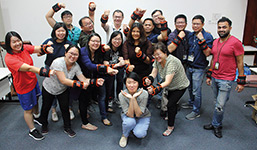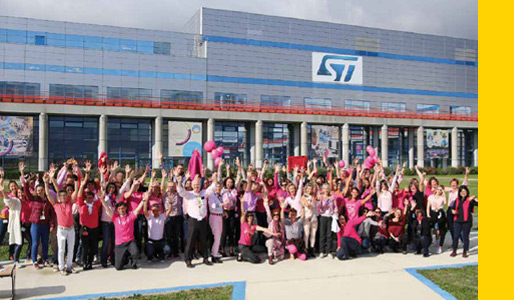Health and Safety
Health & Safety
OUR AMBITION
Be a safe workplace with zero injuries, zero occupational diseases and ensure healthy lives and well-being for all.
2025 GOAL
<0.15%
recordable cases (RC)* for employees and contractors
* injuries and illnesses
RC for employees includes injuries only.
RC for contractors not yet available.
Maintaining a healthy and safe workplace at all our sites is about more than just policies and procedures; it is about building a culture of health and safety alongside our employees and subcontractors and promoting well-being everywhere and for everyone. We believe that investing in employee health improves both vitality and productivity, energizing the entire organization and improving results. Accordingly, we take a strategic approach to creating safe and pleasant workplace environments that promote both physical and mental health among employees. I 103-1 I
Health
Promoting employees’ health and well-being
We believe in helping our employees to adopt healthy lifestyles because we know good health is the foundation of a fulfilling and productive life. Our health plan provides our employees with a very high level of medical care, including:
- regular medical check-ups
- blood tests
- audiometric tests
- ophthalmologic exams
- vaccinations
- cancer prevention screening
One example is the sponsored digital mammograms at our Bouskoura site (Morocco), available to all female employees aged 50 years and over.
>97,000
medical acts conducted worldwide
We also promote employees’ health and well-being through local initiatives. This helps us to anticipate risks and take preventive action. Thanks to this approach, each site can design a health program that is tailored to local needs (see Focus).
For example, at our Crolles site (France), our employees appreciated the ‘Santé vous Bien’ (or ‘Feel Good’) program, which aims to improve different aspects of working conditions, such as:
- ergonomics
- stress management
- work environment
- relations between colleagues
I 103-2 I
|
2015 |
2016 |
2017 |
2018 |
2019 |
||||||
|---|---|---|---|---|---|---|---|---|---|---|---|
|
|||||||||||
Medical examinations |
47,278 |
57,871 |
62,008 |
64,938 |
63,722 |
||||||
Check-up with a physician |
21,978 |
25,476 |
26,574 |
28,225 |
28,423 |
||||||
Blood tests (including biomonitoring tests(2)) |
11,981 |
16,027 |
16,774 |
16,392 |
15,449 |
||||||
Chest X-rays |
6,906 |
6,544 |
9,478 |
10,872 |
7,820 |
||||||
Colorectal cancer immuno cult tests |
436 |
861 |
1,023 |
608 |
975 |
||||||
Electrocardiograms |
4,194 |
6,644 |
5,592 |
7,165 |
7,814 |
||||||
Mammography |
626 |
406 |
561 |
318 |
838 |
||||||
Pap smear tests |
766 |
1,169 |
742 |
846 |
1,347 |
||||||
Prostate cancer screenings |
391 |
744 |
1,264 |
512 |
1,056 |
||||||
Screening tests |
13,693 |
15,209 |
12,348 |
19,280 |
31,509 |
||||||
Immunizations |
1,606 |
1,428 |
1,861 |
3,524 |
2,484 |
||||||
Total services provided(3) |
62,577 |
74,508 |
76,217 |
87,742 |
97,715 |
||||||
Lean on me

FOCUS
Targeted weight loss program in Singapore
At our Ang Mo Kio site (Singapore), targeted weight loss intervention is part of our Workplace Health Promotion program.
ST partners with an external service provider in a 15-week targeted weight loss program. The program prescribes a holistic approach to healthy weight management by incorporating on-site, nutritionist-led educational talks and workshops, and fitness classes. A rewards system and team motivation are also built into the program to encourage successful outcomes.
The program is open to any employee who meets the body mass index and health status participation criteria, and the program fees are fully covered by ST. In 2019, four programs were run at the site, involving 75 participants.
Safety
Our recordable case rate for employees was on target in 2019, reaching 0.16. Our severity rate, however, increased to 2.50 compared to a target of 2.00. This was mainly due to working days lost after on-site domestic accidents – falls and slips – that were not directly linked to our manufacturing or business activity. We therefore remain focused on driving further improvements in employee behavior and working conditions.
0.16
recordable injury case rate
Recordable cases rate(1) I 403-2 I
Severity rate(1) I 403-2 I
We work proactively at all levels to identify potential issues or concerns in the workplace, develop measures to address them, and make it easier for people to get their jobs done. We align our programs with industry risks, with a priority on preventing employees’ potential exposure to hazards such as chemicals (see Chemicals), fire, radiation and nanomaterials; and mechanical, handling and ergonomic risks. I 103-2 I
Proactive
initiatives to reinforce safety culture
In line with SDG target 8.8 on the promotion of a safe and secure working environment for employees, we reinforce our safety culture with proactive initiatives such as:
- Emergency Response Team with employees trained to respond to emergencies
- field safety visits performed by trained managers
- monthly meetings to:
- share accidents, incidents including first aid, near misses and high potential incidents
- adapt our prevention and practices to different situations
- safety training that considers human factors and awareness initiatives worldwide

Serge Hutin
Program Manager, FMT Central Functions
Make no mistake, there is one priority at ST that is valued and shared on all the sites I’ve visited worldwide, whatever their culture – people’s safety! I’m very proud to have been able to train the safety community that takes care of all ST employees.”
Learning from Incidents (LFI) is part of our safety training that considers human factors. It is an investigation process for safety incidents and accidents that aims to identify all the technical and systemic causes. LFI helps to minimize the potential for a recurrence by taking into consideration the inevitability of human error. In 2019, we trained more than 50 people in France, Italy and Asia on LFI.
Safety First everywhere for everyone
In ST, it is standard practice to inform all workers about our safety requirements, communicate with them and train them. Our Safety First program includes all people working on ST sites – employees and subcontractors – in line with our safety policy and OHSAS requirements that every person in the workplace be treated in the same way.
In 2019, the Lost Workday Case (LWDC) incident rate for subcontractors was better than our target of 0.27, reaching 0.26. I 103-3 I
0.26
Subcontractor Lost Workday Case incidence rate
|
2015 |
2016 |
2017(1) |
2018 |
2019 |
||
|---|---|---|---|---|---|---|---|
|
|||||||
Lost workdays cases per |
0.40 |
0.35 |
0.24 |
0.29 |
0.26 |
||
Contributing to the Sustainable Development Goals
Our commitments and programs as described above contribute to:
SDG target 3.8 – Achieve universal health coverage, including access to quality essential healthcare services and access to safe, effective, quality and affordable essential medicines and vaccines for all.
SDG target 8.8 – Protect labor rights and promote safe and secure working environments for all workers.
2019 OBJECTIVES |
Status |
Comments |
|
Employee severity rate ≤2.0. |
|
2.5 |
|
|
Main on-site subcontractors Lost Workday Case rate (LWDC) ≤0.27. |
|
0.26 |
|
Recordable cases for employees ≤0.16. |
|
0.16 |


